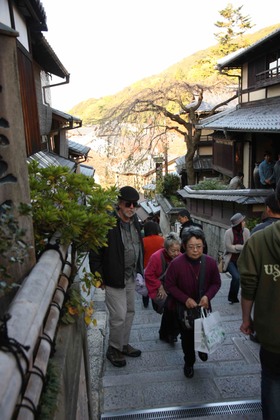
Anyway, with the walk through the temple out of the way it was a matter of making our way back to the hotel, which, basically, should have been a matter of making our way down to a bus stop and proceeding from there.
Unfortunately, the way down from the temple itself takes you through the steep and busy lanes of the atmospheric Higashiyama District, winding streets lined with shops and stalls, and this is where the failure to take the bus on the way up kicked in big time.
The actual Higashiyama District (Higashiyama-ku, or east mountain) covers the eastern part of Kyoto's city centre along the lower slopes of the Higashiyama mountain range and extends a fair bit further than the section we traversed, as far, in fact, as the Philosopher's Path to Ginkakuji Temple which was one of the sakura season highlights last time around.
Fortunately, as subsequent research revealed, it's the sort of place you're going to be heading back to, hopefully with the tiredness taken out of the equation since it is, by all accounts, one of the city's best preserved historic districts and a genuine reflection of traditional Kyoto, especially between Kiyomizudera and Yasaka Shrine where the narrow lanes, wooden buildings and traditional merchant shops invoke a feeling of the old capital , which was the way we went. They've even gone to the extremes of removing telephone poles, doing away with the spider web of cables and wires you find above most Japanese streets and and repaving the roadway to maintain the traditional feel of the district.
Streets in Higashiyama are lined by shops, cafes and restaurants that have been catering to tourists and pilgrims since some time around the 14th century, selling local specialties such as Kiyomizu-yaki pottery, as well as gift culture staples like sweets, pickles, crafts and other souvenirs.
The walk through Higashiyama from Kiyomizudera to Yasaka Shrine is around two kilometres and could be done in half an hour or so, but you you could easily spend much longer visiting the temples, shrines, shops, cafes and restaurants along the way. Maybe next time around we'll be walking beyond Yasaka Shrine past Chionin and Shorenin Temples to Heian Shrine, and possibly even further via Nanzen-ji Temple, with a collection of architecture and artwork from the the late 16th century Momoyama Period. The area also contains the Kyoto National Museum. I expect we'll be back, but next time we'll be getting there by bus, won't we?
The businesses along the way gradually morph from establishments catering to the temple visitor/sightseer trade into a network of interesting streets in a neighborhood that gradually, in turn, morphs into the Gion District, and the further we got away from the temple the more the crowding eased, though you're never in danger of finding tranquility and solitude in any Japanese city, and that's particularly the case when you're in one of the must visit areas of Kyoto.
Kyoto's most famous geisha district, Gion dates back to the Middle Ages, and the shops, restaurants and ochaya (teahouses) located around Shijo Avenue between Yasaka Shrine and the Kamo River originally catered for travellers and visitors to the shrine, but by the mid-18th century the area was Kyoto’s premier pleasure district. From there, the district evolved to become one of the most exclusive and well-known geisha districts in the whole of of Japan.
There are actually five geisha districts in Kyoto where geiko (Kyoto dialect for geisha) and maiko (geiko apprentices) entertain clients, and since geisha are entertainers, not prostitutes, Gion is not, despite popular misconceptions, a red-light district. If that sort of thing floats your boat research suggests you head for Shimabara instead.